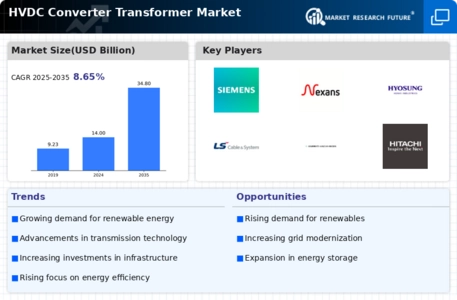Growing Need for Energy Security
Energy security remains a critical concern for many nations, influencing the HVDC Converter Transformer Market. As countries face challenges related to energy supply disruptions, the adoption of HVDC systems is seen as a viable solution. These systems enable the integration of diverse energy sources, including renewables, into the grid, thereby enhancing reliability. The market data indicates that the demand for energy security solutions is expected to grow by 15% annually, further driving the need for HVDC converter transformers. This trend suggests that as energy security becomes a priority, investments in HVDC technology will likely increase, fostering growth in the converter transformer sector.
Rising Urbanization and Electrification
Urbanization is a driving force behind the HVDC Converter Transformer Market, as increasing populations in urban areas demand reliable and efficient power supply. The rapid growth of cities necessitates the expansion of electrical infrastructure, where HVDC technology plays a crucial role. Data suggests that urban areas are expected to see a 30% increase in electricity demand by 2030, prompting utilities to invest in HVDC systems. This trend indicates a growing reliance on HVDC converter transformers to meet the rising energy needs of urban populations. Consequently, the market is likely to expand as utilities seek to enhance grid capacity and reliability.
Increasing Investment in HVDC Infrastructure
The HVDC Converter Transformer Market is experiencing a surge in investment as countries seek to modernize their electrical grids. This trend is driven by the need for efficient long-distance power transmission, which HVDC technology facilitates. According to recent data, investments in HVDC infrastructure are projected to reach USD 20 billion by 2026. This influx of capital is likely to enhance the deployment of HVDC systems, thereby increasing the demand for converter transformers. Furthermore, as nations strive to meet energy demands while reducing carbon footprints, the role of HVDC technology becomes increasingly pivotal. The ongoing investments are expected to bolster the market, leading to advancements in transformer technology and improved operational efficiencies.
Regulatory Support for Clean Energy Initiatives
The HVDC Converter Transformer Market is benefiting from robust regulatory frameworks that promote clean energy initiatives. Governments worldwide are implementing policies that encourage the transition to low-carbon energy systems, which often include HVDC technology. For instance, recent legislation in several regions mandates the reduction of greenhouse gas emissions, indirectly boosting the demand for HVDC converter transformers. Market analysis reveals that regions with stringent environmental regulations are witnessing a 20% increase in HVDC project approvals. This regulatory support not only enhances the market landscape but also encourages innovation in transformer design, aligning with global sustainability goals.
Technological Advancements in Power Transmission
Technological advancements are reshaping the HVDC Converter Transformer Market, leading to more efficient and reliable power transmission solutions. Innovations in materials and design are enhancing the performance of HVDC converter transformers, making them more attractive for utility companies. Recent studies indicate that the efficiency of HVDC systems can exceed 95%, significantly reducing transmission losses. This improvement is likely to drive the adoption of HVDC technology, as utilities seek to optimize their operations. Furthermore, advancements in digital technologies are enabling better monitoring and control of HVDC systems, which may further enhance the market's growth potential.


















Leave a Comment